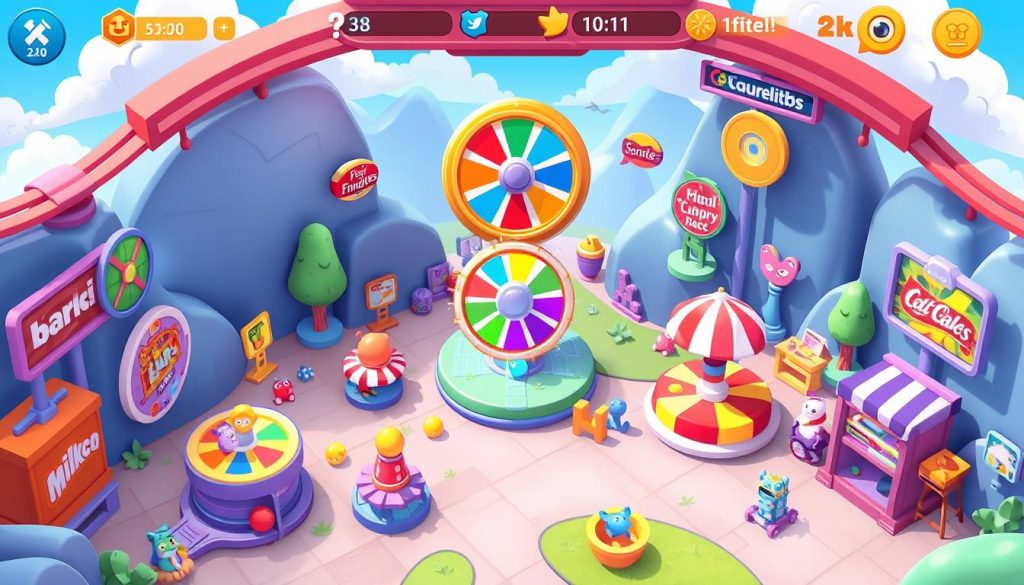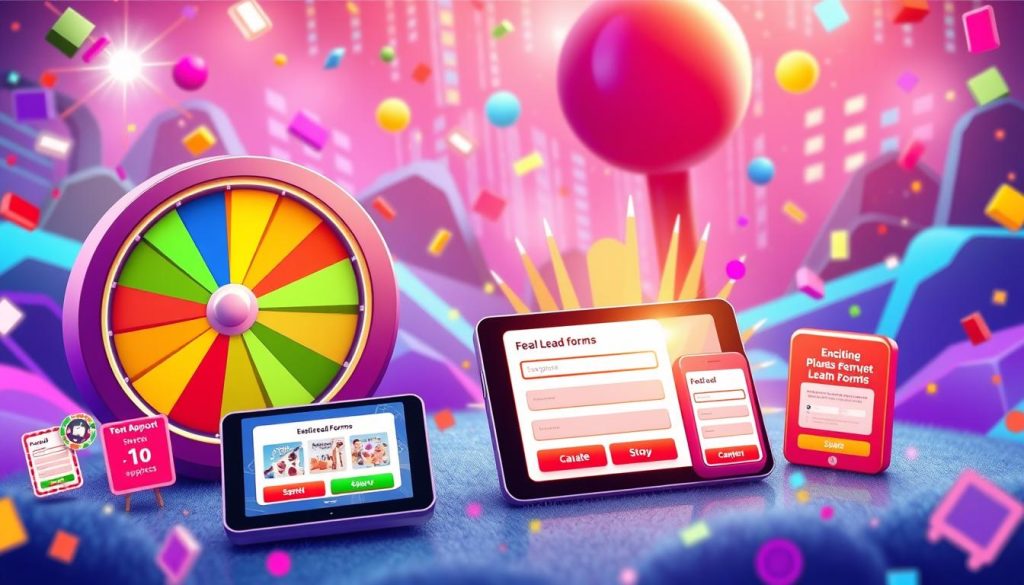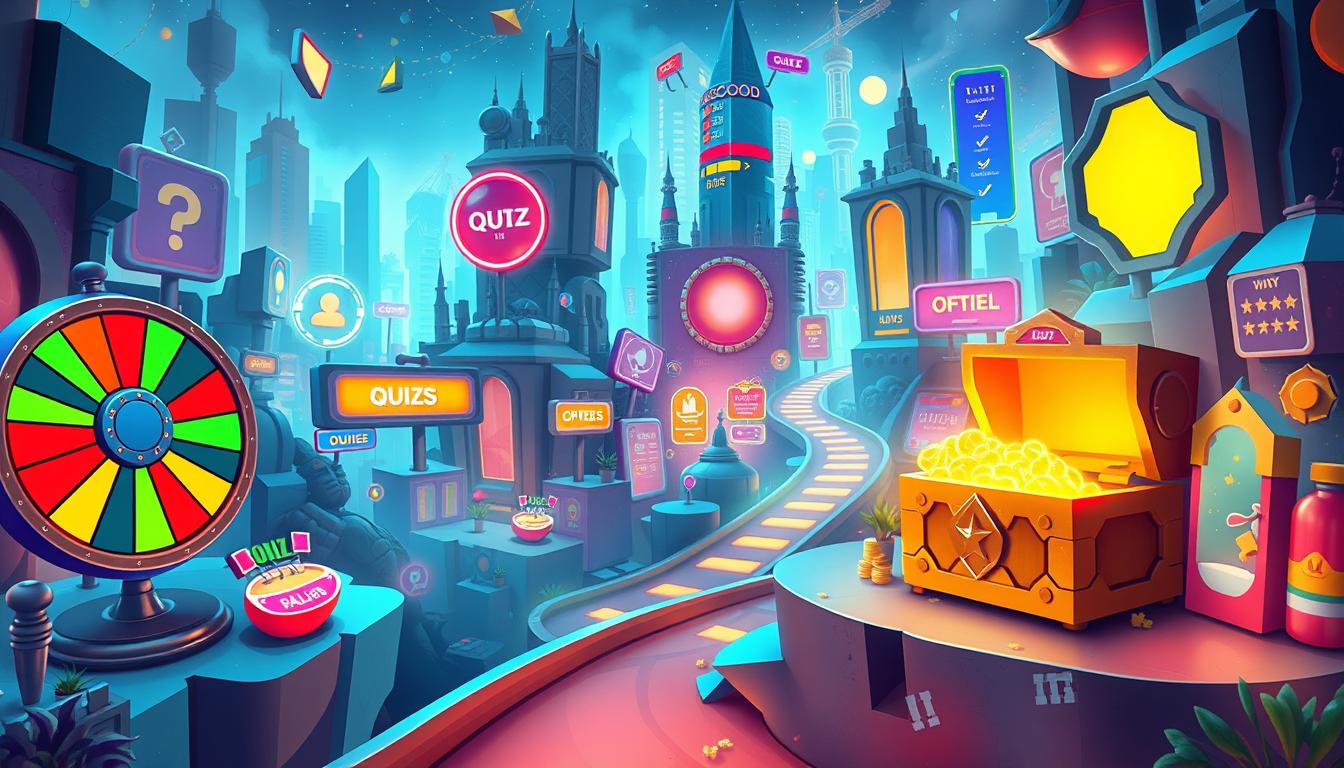In today’s competitive business world, grabbing the attention of potential customers is a big challenge. But, there’s a powerful solution: gamification marketing. It uses branded mini-games or micro-games to engage people, increase brand awareness, and boost lead generation.
Gamification has become a top marketing strategy. It uses our natural love for play, competition, and rewards. By adding interactive content to their campaigns, businesses can create fun and memorable experiences. These experiences not only entertain but also educate and inspire their audience.
Key Takeaways
- Branded mini-games or micro-games can be a highly effective lead generation strategy
- Gamification marketing taps into user engagement and motivation, boosting brand awareness and customer loyalty
- Micro-games can be designed to capture valuable lead information while providing an enjoyable user experience
- Careful planning, design principles, and integration of lead capture strategies are crucial for success
- Measuring and analyzing user engagement and lead conversion is key to optimizing the performance of gamification campaigns
The Power of Gamification Marketing
In today’s digital world, brands are looking for new ways to grab their audience’s attention. Gamification marketing is a key strategy. It uses our natural love for fun and achievement to create engaging micro-games.
Engaging Your Audience Through Interactive Content
Branded mini-games are great at engaging users and boosting user engagement. They tap into our love for play, making brand interaction fun and rewarding. Whether it’s a puzzle, an arcade game, or a strategy game, these experiences are memorable.
Boosting Brand Awareness and Customer Loyalty
Gamification marketing also helps build brand awareness and brand loyalty. Branded games that are fun and match the brand’s look leave a strong impression. This emotional connection leads to better brand recognition and loyalty.
“Gamification is not just about adding points and badges, but about creating experiences that are truly engaging and rewarding for the user.”
The magic of gamification marketing is in mixing fun, engagement, and brand-building. It helps brands capture their audience, increase visibility, and build a loyal fan base. All while driving leads and conversions.
What Are Lead Generation Games?
In the fast-paced world of digital marketing, lead generation games, or micro-games, are becoming key. They engage audiences and help businesses grow. Unlike old ways of getting leads, these games are interactive and fun.
At their heart, lead generation games are short, interactive apps that grab users’ attention. They make people want to share their contact info. This is different from usual lead forms or landing pages. These games use fun and challenge to build a real connection with people.
- Lead generation games are visually appealing and easy to use. They keep users interested and engaged.
- They use gamification, like scores and rewards, to make users feel accomplished. This boosts their motivation to keep playing.
- These games make users want to participate and share their info. This can turn them into valuable leads for businesses.
Unlike old ways of getting leads, which can be boring, lead generation games are fun. They make interacting with a brand enjoyable. This improves the user experience and helps businesses get more leads.
“Lead generation games are a game-changer in the world of digital marketing, transforming the way businesses connect with their target audience and capture valuable leads.”
The Psychology Behind Micro-Games
Micro-games are all the rage in digital marketing, drawing in users and boosting engagement. Their success stems from the complex psychology they tap into. By grasping what drives users, marketers can craft lead generation campaigns that truly engage and motivate.
Tapping into User Engagement and Motivation
Micro-games satisfy our basic needs for fun, challenge, and achievement. They offer quick rewards, which activate our brain’s reward centers. This release of dopamine and endorphins keeps us coming back for more.
They also introduce competition, whether it’s against oneself or others. This competitive edge stirs our drive to win, making us more engaged and eager to play again.
| Psychological Factor | Impact on Micro-Game Engagement |
|---|---|
| Immediate Gratification | Micro-games provide users with a quick sense of achievement, triggering the brain’s reward centers and keeping them engaged. |
| Competitive Nature | Incorporating elements of competition, such as leaderboards or high scores, taps into the user’s innate desire to succeed and outperform. |
| Sense of Progression | As users progress through the micro-game, they experience a sense of accomplishment, which motivates them to continue playing. |
By delving into the psychology of micro-games, marketers can craft experiences that captivate and engage users. This leads to valuable lead generation for their brands.
How Branded Mini Games Can Skyrocket Your Lead Generation
In today’s fast-paced digital world, businesses are always looking for new ways to grab their audience’s attention. One effective strategy is using branded mini games. These fun, short games can help boost your lead generation.
Adding branded mini games to your marketing can really engage your users. These games not only grab attention but also help people connect with your brand. As users play, they’re more likely to remember your brand, which increases brand awareness.
Branded mini games are also great for capturing leads. You can add email opt-in forms or call-to-action buttons to the games. This way, you can get valuable contact info from people who are already interested in your brand.
- Boost user engagement and foster deeper brand connections
- Enhance brand awareness through memorable interactive experiences
- Streamline lead capture with strategic integration of lead-generation tools
- Leverage the power of gamification to drive measurable results
To get the most out of branded mini games, you need to understand what motivates players. Design games that are both fun and focused on your brand. This way, you can make a big impact and boost your lead generation efforts.

“Branded mini games are the ultimate fusion of engagement and lead capture, empowering businesses to connect with their audience in a truly memorable way.”
Creating Captivating Micro-Games
Micro-games are a powerful tool in lead generation. They capture your audience’s attention and boost engagement. To make these interactive experiences, you need to know about micro-game design, user experience, and game mechanics. By using gamification best practices, businesses can make micro-games that entertain and meet their marketing goals.
Design Principles and Best Practices
Creating a successful micro-game needs a mix of key design principles:
- Intuitive User Experience: Make your micro-game easy to get and use. It should have clear goals and controls. This makes the user experience better and keeps players interested.
- Engaging Game Mechanics: Use game mechanics that keep players coming back. This includes tough levels, scoring, and rewards. These elements satisfy our need for competition and success.
- Seamless Brand Integration: Make sure your brand’s look, message, and values are in the micro-game. This boosts brand awareness and connects you with your audience.
- Optimization for Mobile: With more people using smartphones, make sure your micro-game works well on them. It should load fast, work on different screens, and be fun to play.
Following these gamification best practices helps businesses make micro-games that grab attention, increase engagement, and help with lead generation.
“The key to creating a successful micro-game is to strike the perfect balance between entertainment and marketing objectives. It’s a delicate dance, but when executed well, the results can be truly game-changing.”
Integrating Lead Capture Strategies
Businesses are now using lead capture strategies in their micro-games to boost lead generation. They mix different techniques to turn fun content into lead-generating tools. This way, they can get more users to become valuable leads.
One key method is placing opt-in forms in the micro-game. Users get something special, like exclusive content, for sharing their contact info. This helps businesses grow a list of leads ready to interact more with the brand.
Using lead magnets is another smart move. These are things like downloadable guides or special content upgrades. They give users something useful while collecting their user data for marketing. This method makes the user experience better and helps build a strong lead generation pipeline.
Micro-games can also collect data in a fun way. By adding interactive parts that ask for user input, businesses learn more about their audience. This info helps improve lead capture efforts and offer more personalized experiences.
| Technique | Description | Benefits |
|---|---|---|
| Opt-in Forms | Embed forms within the micro-game experience to capture user contact information in exchange for incentives. | Builds a qualified lead database, enables personalized outreach. |
| Lead Magnets | Offer downloadable resources or content upgrades to users in exchange for their information. | Provides value to users, captures user data for targeted marketing. |
| Data Collection | Incorporate interactive elements that require user input to gather insights about audience preferences and behaviors. | Enhances understanding of target audience, informs future lead generation strategies. |
By adding these lead capture strategies to their micro-games, businesses can turn their content into effective lead generation tools. This boosts user engagement and turns their audience into a valuable pool of potential customers.

Measuring Success: Analytics and Metrics
In the world of branded micro-games, knowing how well they do is key. By using micro-game analytics and important user engagement metrics, companies can learn a lot. This helps them improve their interactive content and get better results.
Tracking User Engagement and Lead Conversion
To see how well your lead generation games are doing, watch user engagement metrics. Look at game play time, level completion rates, and social sharing. These show if your games are keeping players interested.
Also, it’s vital to track lead conversion rates. This shows how many players turn into leads or customers. By watching these numbers, you can find ways to make your games better. This leads to more lead conversion and a healthier bottom line.
| Metric | Description | Importance |
|---|---|---|
| Game Play Time | The average duration of a player’s game session | Indicates the level of user engagement and interest |
| Level Completion Rate | The percentage of players who successfully complete game levels | Reveals how effectively the game challenges and retains players |
| Social Sharing | The number of times players share the game on social media | Measures the game’s viral potential and brand awareness |
| Lead Conversion Rate | The percentage of players who convert into leads or customers | Determines the ROI of the gamification marketing strategy |
By keeping an eye on these user engagement metrics and lead conversion rates, companies can really understand their micro-games. This knowledge helps them make smart choices and keep improving their marketing efforts.
“Measuring the success of your lead generation games is essential for understanding their true impact and making informed decisions to drive even greater results.”
Case Studies: Brands Winning with Gamification
Gamification is a key tool for brands wanting to boost lead generation and engage their audience. Many companies have used branded mini games to grab customer attention and turn them into leads. Let’s look at some gamification case studies that show the impact of interactive content.
Pepsi is a great example. They made a branded mini game called “Pepsi Stuff.” Players earned points by playing a game, which they could use to get cool Pepsi stuff. This campaign really worked, increasing brand awareness and lead generation a lot.
Nissan also had a hit with their “Nissan Rogue Challenge” game. Players navigated a virtual course to win prizes and learn about the Nissan Rogue. This fun game not only raised brand awareness but also brought in a lot of qualified leads.
| Brand | Gamification Campaign | Key Results |
|---|---|---|
| Pepsi | Pepsi Stuff | Increased brand awareness and lead generation |
| Nissan | Nissan Rogue Challenge | Boosted brand awareness and generated qualified leads |
These gamification case studies show how branded mini games can help with lead generation and customer engagement. By understanding how to engage users, brands can make fun, interactive experiences. These experiences not only entertain but also turn people into valuable leads.
“Gamification has changed how we get leads, making it possible to create experiences that really connect with our audience.”
As more people want interactive content, more brands are using gamification marketing to get leads. By learning from these successful examples, businesses can make their own branded mini games. This can help them grow and succeed.
Choosing the Right Gamification Platform
Choosing the right gamification platform is key for developing branded micro-games. The platform you pick affects the quality, features, and success of your games. Businesses need to consider several important factors when exploring gamification platforms.
Features to Look for and Considerations
To make your micro-game development a hit, focus on these key features and considerations:
- User-Friendly Interface: The platform should have an easy-to-use and attractive interface. This makes it simple for your team to create and customize engaging games.
- Analytical Capabilities: Look for platforms with detailed analytics and reporting tools. These tools help you track user engagement, spot trends, and measure your lead generation games‘ success.
- Integration Options: It’s important to find platforms that integrate well with your marketing and sales systems. This lets you capture and nurture leads from your micro-game development efforts.
- Scalability and Flexibility: Choose a platform that can grow with your business. It should allow you to create and manage many gamification platforms as your needs change.
- Developer Support: Having access to a skilled support team and detailed documentation is crucial. It can greatly impact the success of your platform features and project.
By carefully looking at these factors, businesses can find the perfect gamification platform. This platform will help create engaging micro-games that boost lead generation.
Gamification Marketing Trends and Future Outlook
Digital marketing is changing fast, and gamification is playing a big role. Branded micro-games and interactive content are great for grabbing people’s attention. They help drive lead generation. Experts say gamification marketing will keep growing and getting more creative.
Augmented reality (AR) and virtual reality (VR) are big in gamification marketing now. They let brands create immersive experiences. This is changing how brands connect with customers. As people want more personal digital experiences, AR and VR will become even more popular.
There’s a big push for micro-games and short, fun content. Brands know people’s attention spans are short. So, they’re making quick, engaging games. These games not only entertain but also help gather user data and generate leads.
| Gamification Marketing Trends | Future Outlook |
|---|---|
| Rise of AR and VR technologies | Continued growth and innovation in immersive experiences |
| Emphasis on micro-games and bite-sized interactive content | Increasing demand for quick, engaging gaming experiences |
| Personalization and data-driven optimization | Leveraging user data to create highly targeted and effective campaigns |
In the future, gamification will be key for lead generation. Brands that use micro-games and interactive content will grab their audience’s attention. They’ll build stronger connections and see great results in lead generation.
“The future of marketing lies in creating immersive, personalized experiences that capture the hearts and minds of consumers. Gamification is the key to unlocking this potential.”
Conclusion
Branded mini games are a strong tool for lead generation. They use gamification marketing to engage people, increase brand awareness, and get valuable leads. These leads can help your business grow.
Micro-games work because they tap into what motivates users. They create meaningful interactions. When done right, these games can boost your lead generation. They make the experience fun and seamless for your customers.
This article covered the key points for making effective micro-games. It talked about game design and how to capture leads. By keeping up with trends and choosing the right platform, your business can thrive in this exciting field.
FAQ
What are branded mini games?
Branded mini games, or micro-games, are fun digital experiences that match a brand’s identity. They are short games made to grab attention and encourage actions like lead generation or brand awareness.
How can branded mini games skyrocket lead generation?
Branded mini games can boost lead generation by engaging users and increasing brand awareness. They tap into what users want, like fun and achievement, to get them involved. This can make the brand more visible and build stronger customer ties, leading to more leads.
What are the key benefits of using gamification marketing?
Gamification marketing boosts user engagement, brand loyalty, and lead capture. Branded mini games can draw in audiences, create emotional bonds, and gather valuable data. This makes them a great way to get more leads.
What design principles should be considered when creating captivating micro-games?
When making micro-games, focus on user-friendly design, fun game mechanics, and clear brand integration. The game should align with marketing goals. A well-designed game that puts users first is key to success.
How can businesses effectively integrate lead capture strategies into their branded mini games?
Businesses can add lead capture to their games by using opt-in forms, lead magnets, and data collection. By blending these into the game, they can turn engaged players into valuable leads.
What key metrics should be tracked to measure the success of branded mini games?
To gauge success, track user engagement, lead conversion rates, and ROI. These metrics show how well the games work and help improve future strategies.


